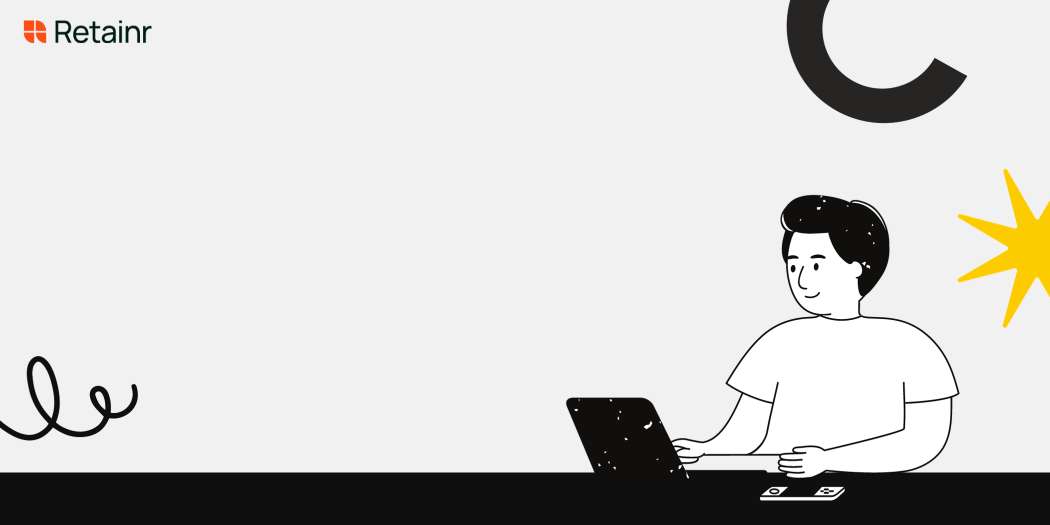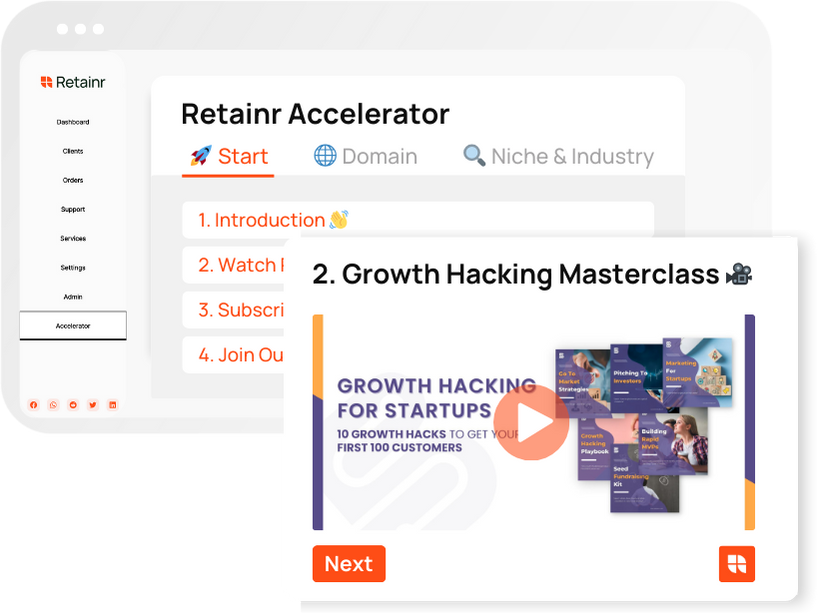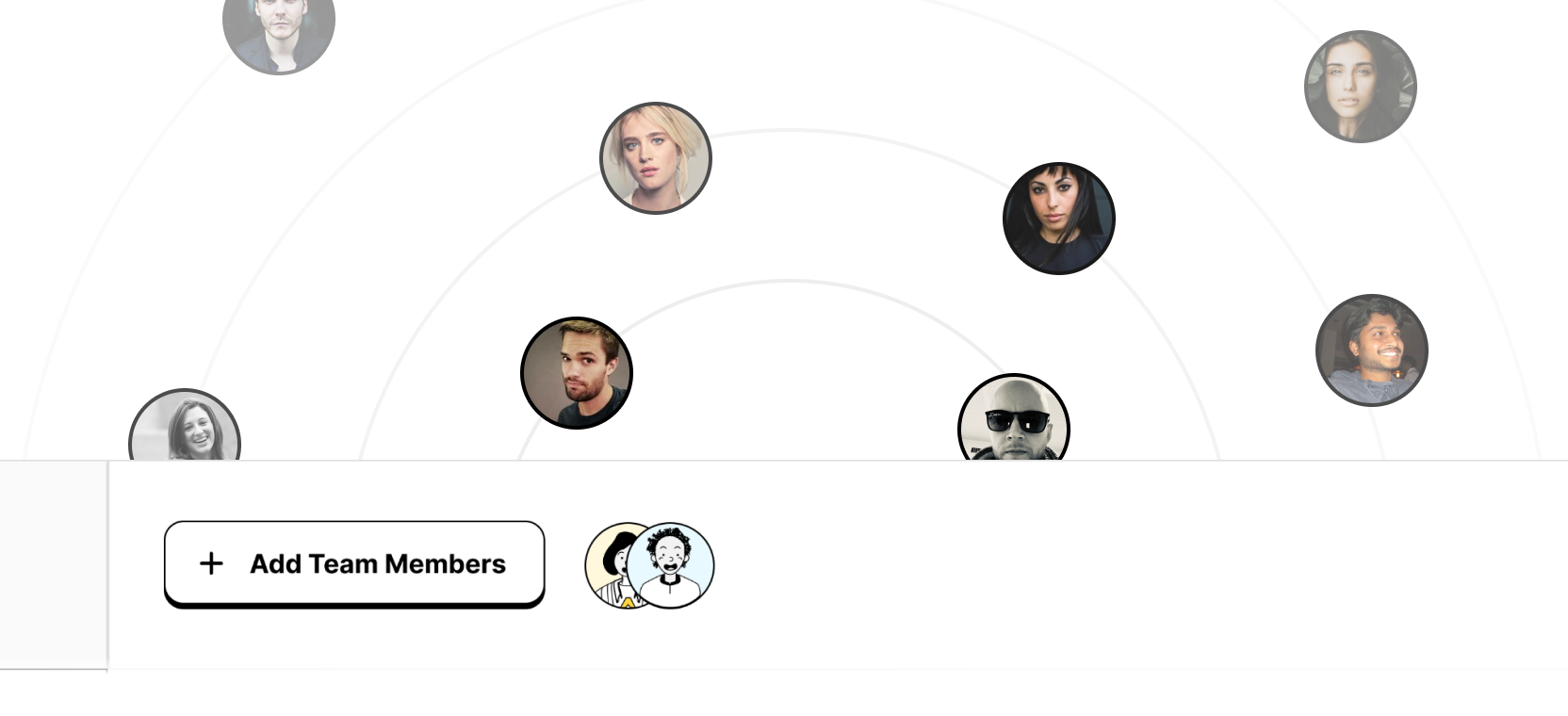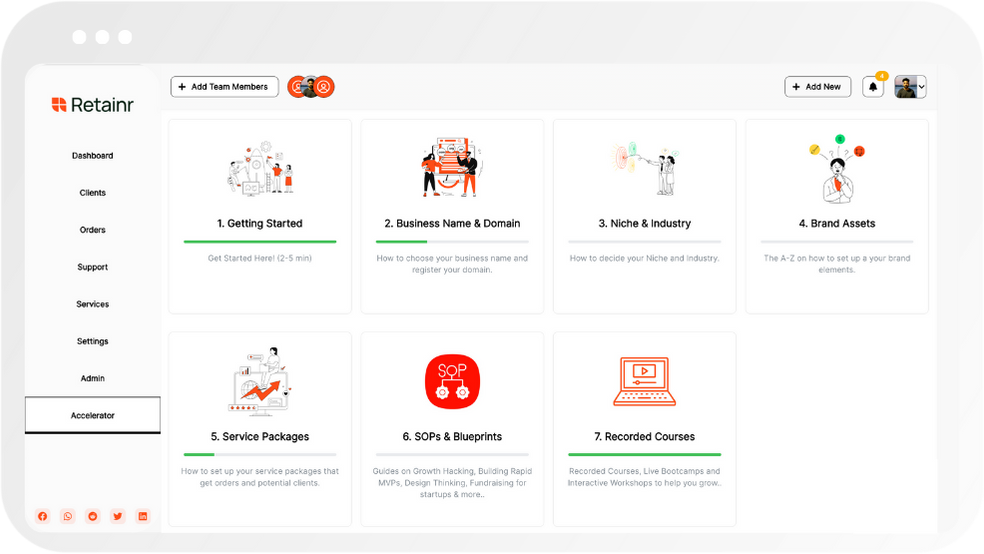
8 Tips For Building A Killer Freelancer Portfolio From Scratch
Build with Retainr
Sell your products and services, manage clients, orders, payments, automate your client onboarding and management with your own branded web application.
Get Started1. What are some tips for building a killer freelancer portfolio from scratch?
Proactive Self-Presentation
Building a killer portfolio begins with promoting oneself effectively and emphasizing one's skills and strengths. Understand your skill set and ensure you present it professionally and attractively. Some tips for efficient self-presentation include:
- Create an engaging ‘About Me’ section that resonates with your personality.
- Highlight your most relevant skills and experiences.
- Use action words and present real numbers to demonstrate your achievements.
Compelling Showcase of Work
To truly impress potential clients, you need to present them with work samples that showcase your expertise, creativity, and commitment to quality. Below are some suggestions on how to effectively showcase your work:
- Categorize your work samples based on the different skills they represent.
- Highlight your best work over the span of your career, and prioritize quality over quantity.
- Include any attractive testimonials from previous clients.
- Ensure all work samples are high-resolution and professional.
Demonstrate Professionalism and Credibility
Ultimately, your portfolio needs to assure clients of your professionalism and credibility. This can be achieved by:
| Tip | Explanation |
|---|---|
| Adding a professional headshot | First impressions matter, and your image is a significant part of that. |
| Providing clear and concise contact information | No one likes dealing with hard-to-reach professionals. Make it easy for clients to contact you. |
| Maintaining an active online presence | Regular updates indicate that you are active, available, and up-to-date. |
2. Can you explain the importance of including sample work in my freelancer portfolio?
The Significance of Including Sample Work
Illustrating your expertise and skills succinctly is vital to make your freelancer portfolio impressive. The inclusion of sample work in your portfolio serves this purpose. It is a visual and tangible representation of your competencies, style, and specialization.
- It showcases your talent and proficiency. You might claim to have various skills and expertise, but without evidence, these claims are of no value. Your sample work serves as a testament to your abilities.
- It provides a sneak peek into your professional style. The way you handle projects and your distinctive style of work is reflected in the samples. Clients would always prefer to know your working style before deciding to work with you.
- It gives an idea about your specialization. Your samples tell the potential clients what type of projects you specialize in or what kind of tasks you are more comfortable handling.
Importance of Sample Work in Numbers
In a professional landscape, numbers often speak louder than words. The below table sheds some light on the significance of including sample work in your portfolio.
| Benefits | Percentage of Clients that Consider it Important |
|---|---|
| Shows Proficiency | 90% |
| Reflects Professional Style | 80% |
| Ideas about Specialization | 85% |
3. What type of personal brand should I try to convey in my portfolio?
Creating Your Personal Brand
Firstly, you have to understand what a personal brand is. Your personal brand is how you present yourself to prospective clients. It's your values, your skills, your personality, and your unique style, all wrapped up into a cohesive and captivating package. A solid personal brand can communicate your unique value proposition, differentiate you from other freelancers, and build trust in your prospective clients, convincing them that you are the best fit for their needs.
What to Consider for Your Personal Brand
Choosing the right personal brand can be challenging but here are some factors to consider:
- Authenticity: Your brand should be a true reflection of who you are and what you bring to the table. Do not pretend to be someone you're not.
- Consistency: Your brand needs to be consistent across all mediums. This includes your portfolio, business cards, resume and even your social media accounts.
- Distinctiveness: Your personal brand should be unique and set you apart from other freelancers in your field.
- Relevance: Your personal brand should connect with your desired client base and be relevant to the industry in which you wish to work.
Visual Representation of Your Personal Brand
A table serves as another effective way of communicating your personal brand's key elements:
| Element | Example |
|---|---|
| Name | Use your name or business name |
| Logo | Create a unique and representative logo |
| Tagline | A catchy line summing up what you do |
| Colors | Choose color combinations representing your brand |
| Fonts | Find easy-to-read, engaging, brand-representative fonts |
Remember, you want your portfolio to stand out in the mind of the client. So, make sure it's unique and represents who you are and what you can deliver effectively.
4. How can I translate my skills and experience into an effective freelancer portfolio?
Identifying Your Key Skills and Experience
Before you start creating your portfolio, it's crucial to identify your key skills and large-scale experience. Make a list of your distinguishing attributes, such as professional certifications, awards, languages known, and tech skills. Not only should your list be exhaustive, but it should also prioritize skills that align with your ideal projects or clients. For instance:
- Certified Project Management Professional
- Fluent in English, French and Spanish
- Proficient with JavaScript, CSS, and HTML
- Experience in content editing and proofreading
Structuring Your Portfolio Around Your Skills
The structure of your portfolio should revolve around your most valuable skills and experience. This should be showcased directly and indirectly in all sections, be it in the 'About Me' or 'Projects' section. Here’s a simple table depicting how you can present your skills:
| Skill | Description | Project |
|---|---|---|
| Web Development | Proficient in HTML, CSS, and JavaScript | Developed a responsive e-commerce website |
| Bilingual | Fluent in English and French | Translated online articles from English to French |
Using Work Samples to Highlight Your Skills
One major way to translate skills into a freelancer portfolio is through work samples. Provide links, screenshots, or descriptions of key projects where you utilized your skills. For example, in a design portfolio, show both the rough sketches and final products to demonstrate your design process. As a writer, include samples that show your versatility in various writing styles. You can even add some components of your work in progress to emphasize your flexibility and adaptability to various conditions. Remember to detail the role you played in each project and the value you brought.
5. Can I include projects from my personal hobbies or interests in my portfolio?
Understanding Portfolio Diversity
Yes, absolutely! Your portfolio should reflect your skills, creativity, and adaptability. If a project from a personal hobby or interest demonstrates your aptitude in a particular area, then it's worth including. Personal projects can often show skills that may not be easily seen in professional work from a corporate setting. For instance, if photography is your hobby and you’ve done some exceptional work, it can be added to your portfolio to show your aesthetic sense and creativity.
- Graphic Design: Your passion for digital art or graphic design can be demonstrated using visually appealing illustrations or logos.
- Web development: If you've created a website or app as part of your personal hobby, providing links or snapshots of your work can help demonstrate your coding skills.
- Content Writing: If you run a personal blog or have written several thought pieces, you can include these writings to showcase your ability to effectively communicate and swell a story.
Structuring Your Portfolio
When incorporating personal projects into your portfolio, their structure matters a lot. You can use a table to present your projects in a systematic way so that it is easier for your clients to understand your skills and experiences. Here is a table template on how to organize and structure your portfolio:
| Project Name | Skills Used | Project Objective | Project Link (If available) |
|---|---|---|---|
| Personal Blog | Content Writing, SEO | To share personal experiences and thoughts | www.exampleblog.com |
| Landscape Photography | Photography, Editing | To capture and display aesthetic beauty of landscapes | www.examplephotography.com |
It's also important to include explanations for each project, explaining what the project is about and how you went about executing it, as well as a brief on what skills were used in the project. This helps clients have an understanding of your work process and problem-solving skills.
6. What are some common mistakes to avoid when building a freelancer portfolio from scratch?
Common Mistakes to Avoid
While constructing your freelance portfolio, it's important to sidestep some common pitfalls to maximize its effectiveness. One of the most common missteps include loading your portfolio with every piece of work you've ever completed. It's vital to curate your portfolio judiciously, including only distinguished samples that reflect your skills and versatility. Quantity never trumps quality.
- Overloading with Numerous Projects: It's a common misconception that the more pieces it contains, the better portfolio may seem. However, it can prevent prospective clients from finding your best works.
- Outdated Samples: The world changes and so should your portfolio. Leave no room for outdated samples as they may leave an impression that your skills are no longer relevant.
- Lack of Context about Work Samples: Each piece in your portfolio should provide context so clients can understand its purpose and your role in its creation.
More Portfolio Building Mistakes to Avoid
The blunders don't end there. Below, you'll find a few more common mistakes entrepreneurs often make when crafting their freelance portfolios.
| Mistake | Why to Avoid |
|---|---|
| Ignoring Presentation | An unattractive, poorly organized portfolio can distract or even deter potential clients. Aim for crisp, professional aesthetics. |
| Not Tailoring to Target Market | If your portfolio doesn't demonstrate projects relevant to your target clients' needs, they might not see the value in hiring you. |
| Neglecting to Present Testimonials or References | Impressive work samples are crucial, but endorsements from satisfied customers amplify their impact, providing credible proof of your expertise. |
7. How frequently should I update my freelancer portfolio?
Importance of Updating Your Freelancer Portfolio
One common question many freelancers have is about how often they should update their portfolios. The answer depends on several factors, but a good rule of thumb is that you should update your portfolio whenever you have new, significant work to showcase. This might mean you update your portfolio a few times a year or even once a month. Here are a few reasons behind the importance of regular updates:
- New clients: Prospective clients like to see recent work.
- Stay relevant: Regular updates help you stay current with the latest trends.
- Showcase improvement: Frequent updates show your professional growth and progress.
When Should I Update My Freelancer Portfolio?
The ideal frequency of updates to your portfolio depends on your type of work and personal circumstances. However, a general guideline can be found in the table below:
| Type of Work | Recommended Update Frequency |
|---|---|
| Design or Photography | After every significant project |
| Writing or Editing | Monthly |
| Programming/Developing | Quarterly |
| Consulting | Semi-annually |
Tips for Updating Your Portfolio
When updating your freelancer portfolio, you should focus on showcasing your best work, not just your most recent work. Always select the projects that best represent your skills and expertise. Some tips for updating your portfolio include:
- Quality over quantity: It’s better to have a few high-quality examples than a lot of mediocre ones.
- Client feedback: Include any positive feedback or testimonials you have received from clients.
- Variety: Show a broad range of your skills, not just projects from one area of your expertise.
8. Can you provide tips on how to make my freelancer portfolio more attractive to potential clients?
Designing Your Portfolio in a Client-Friendly Manner
Attracting potential clients to your freelancer portfolio is a touch of art. Firstly, ensure your portfolio is highly responsive. This means it should be user-friendly across all devices such as laptops, mobile phones, or tablets. Clients appreciate a seamless online browsing experience. Secondly, make sure your portfolio is intuitively navigated which can be done by keeping pages and sections clear and simple. Include a clearly labeled menu bar to make it easy for the client to navigate the site without having to guess where to go next.
Showcasing Your Best Work
Your portfolio should serve as a platform to show off your best work. When selecting work to feature, prioritize quality over quantity. Choose projects you're most proud of and that represent your range of skills and experiences. Use a grid layout to display your work, with thumbnails leading to a more detailed view of each project. Consider including a brief description under each work sample that provides some context about the project for the client.
| Project | Description |
|---|---|
| Promotional Video | Created a promotional video for XYZ Company showcasing their new product line. |
| Website redesign | Overhauled the website design of ABC Corporation. Increased web traffic by 25%. |
Making Your Portfolio Accessible and Personable
Lastly, make it easy for potential clients to find and contact you. Include a contact form or your professional email address in a conspicuous location on your website. It's also recommended to integrate your social media handles into your portfolio to give your clients a peek at your professional network and your following. Moreover, don't forget to add a bio and a professional photograph of yourself to give a human touch to your online presence. This will help clients connect with you on a more personal level, and remember, people prefer to work with individuals they feel they know and like.
9. How can I use my portfolio to effectively communicate my unique selling points as a freelancer?
Identify Your Unique Selling Points
Start by identifying your unique selling points (USPs). Your USPs could be your specialized skills, your efficiency, your multifaceted expertise, your experience in a particular niche, or other unique traits that set you apart from the competition. Make a list of your top USPs that align with the needs and preferences of your target audience:
- Specialized skillsets
- Outstanding efficiency
- Multifaceted expertise
- Experience in a specific niche
- Exceptional customer service
Highlight Your USPs in Your Portfolio
Once you've identified your USPs, the next step is to highlight them in your portfolio. You can do this through a combination of textual content, visuals, and samples of your previous projects. Consider creating a dedicated section on your portfolio page to showcase your USPs. For example, create a table detailing your skillsets, the projects you've handled related to those skills, and their outcome:
| Skillset | Relevant Projects | Outcomes |
|---|---|---|
| Web Design | Website redesign for ABC Corp | Increased engagement by 45% |
Showcase Reviews and Testimonials
Another great way to communicate your USPs is through reviews and testimonials from your previous clients. Positive feedback from former clients showcases your capability to meet and exceed expectations. It signals the quality of service you offer, your work ethics, and the manner in which you interact with clients. So, ensure to include a section in your portfolio to display these reviews and testimonials that highlight your USPs:
- Quality of service
- Work ethics
- Professionalism
- Client satisfaction
10. Why is it advisable to include testimonials or feedback in my portfolio?
Significance of Client Testimonials and Feedback
Client testimonials and feedback play a pivotal role in building an impressive freelancer portfolio. They serve as social proof of your expertise and abilities, instilling trust and confidence in potential clients. Three major reasons for including testimonials in your portfolio are:
- Proof of Legitimacy: Testimonials serve as validation for your work. They show that you have successfully worked with multiple clients before and they were satisfied with your services.
- Establishing Trust: Positive reviews have a psychological effect on potential clients. It invokes trust and creates a sense of security about your service.
- Highlighting Working Style: Feedback can provide insights to potential clients regarding your working style, dedication, and attitude. From the client’s perspective, these are essential traits they look for in a freelancer.
Strategically Utilizing Testimonials in Portfolio
How and where you present the feedback matters as much as the testimonials themselves. To employ them most effectively, you might consider:
| Strategy | Description |
|---|---|
| Collating Them: | Instead of scattering testimonials all over your portfolio, dedicate a separate section for them. This approach provides a consolidated view of all your accolades. |
| Highlighting Pertinent Information: | Emphasize pertinent information such as the project type or the client’s industry. This gives future clients an idea about your experience in different fields. |
| Accompanying With Work Examples: | Presenting testimonials alongside corresponding work samples links praises directly to your tangible output, thus creating a powerful impact. |
Requesting for Client Testimonials and Feedback
It's perfectly fine to ask your clients for testimonials and without them, you may miss out on highlighting these advantages. Here are a few ways to solicit feedback:
- To ensure that testimonials are genuine and effective, ask clients for feedback soon after completing a project when details are still fresh.
- Directly ask clients to provide a testimonial. A polite request often yields helpful feedback.
- Provide a guided format to leverage the feedback effectively. Ask clients to mention the service they availed, challenges they faced, and how your services helped in overcoming those.
Conclusion
Building an Outstanding Freelancer Portfolio: Eight Essential Tips
Creating a stellar freelancer portfolio from scratch doesn’t have to daunting. With the right approach, you can effectively showcase your skills and expertise. Here are eight tips to help you build a killer portfolio:
- Create a clear, concise introduction: Make the first impression count with a brief and engaging about section.
- Display your best work: Include only your top-quality projects that truly reflect your abilities.
- Include testimonials: Client testimonials instill confidence in your services and highlight your professionalism.
- Detail your process: Explaining your work methodology helps clients understand how you approach a project.
- Show variety: Show a range of work to demonstrate your versatility and breadth of experience.
- Create a compelling case study: Choose a standout project and create a detailed case study to highlight your skills.
- Keep it updated: Regularly updating your portfolio keeps it fresh and relevant.
- Effective presentation: A well-designed and easy-to-navigate portfolio makes a powerful statement.
Improve your Freelance Business with Retainr.io
After building your killer portfolio, next is to manage your freelance business effectively. This is where Retainr.io comes in. It's a whitelabel software that helps you sell, manage clients, orders, and payments with your own branded app.
From invoicing to client management, Retainr.io is designed to streamline your freelance operation for greater productivity and client satisfaction. By simplifying these integral processes, it gives you more time to focus on what matters most—delivering high-quality work to your clients.
Experience freelance business management like never before with Retainr.io.
Boost Your Agency Growth
with Retainr Accelerator
Uncover secrets, strategies, and exclusive blueprints to take your agency's growth to the next level — from marketing insights to effective presentations and leveraging technology.

SOPs, Cheatsheets & Blueprints
Leverage 50+ SOPs (valued over $10K) offering practical guides, scripts, tools, hacks, templates, and cheat sheets to fast-track your startup's growth.
Connect with fellow entrepreneurs, share experiences, and get expert insights within our exclusive Facebook community.
.jpg)

Join a thriving community of growth hackers. Network, collaborate, and learn from like-minded entrepreneurs on a lifelong journey to success.

Gain expertise with recorded Courses, Live Bootcamps and interactive Workshops on topics like growth hacking, copywriting, no-code funnel building, performance marketing and more, taught by seasoned coaches & industry experts.

.jpg)

.jpeg)


